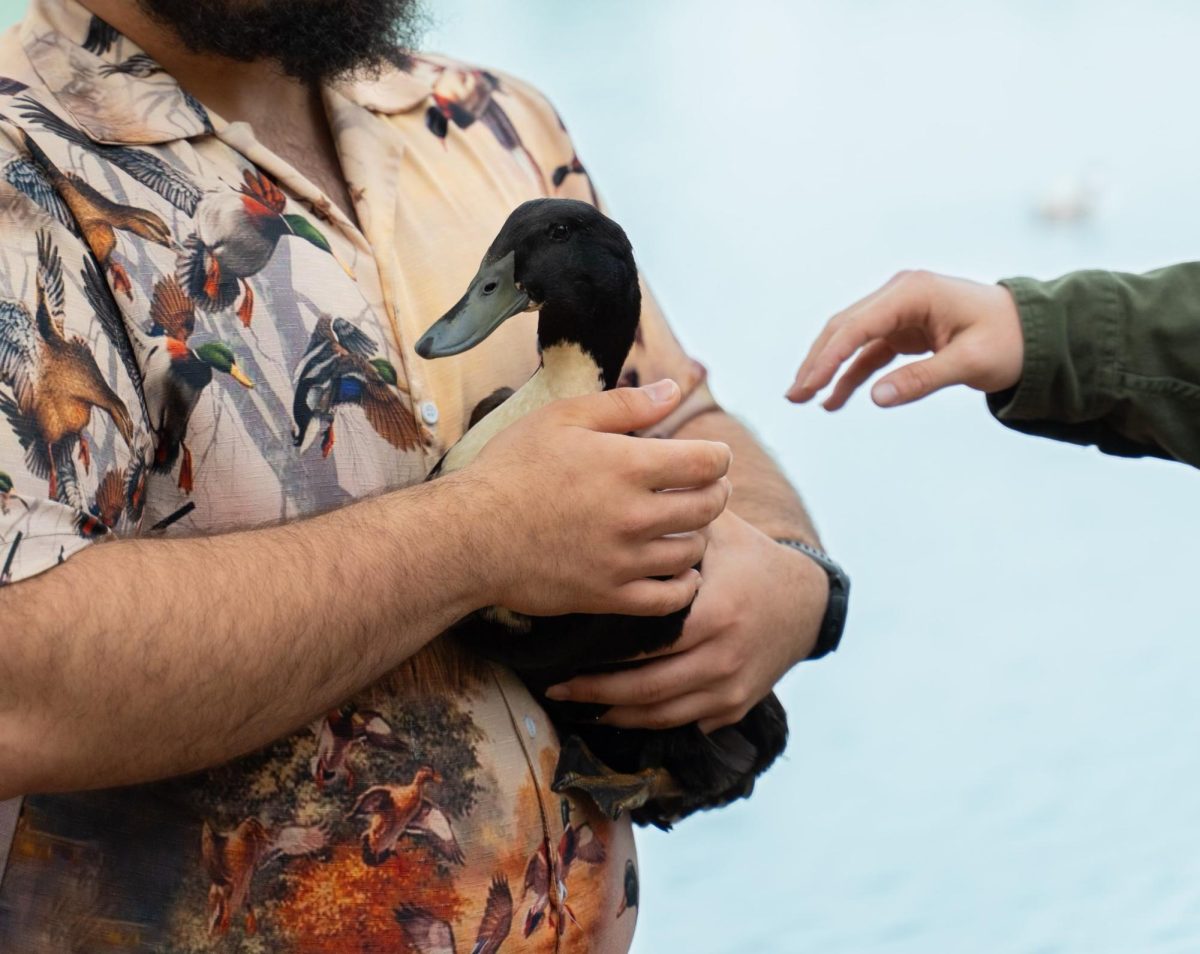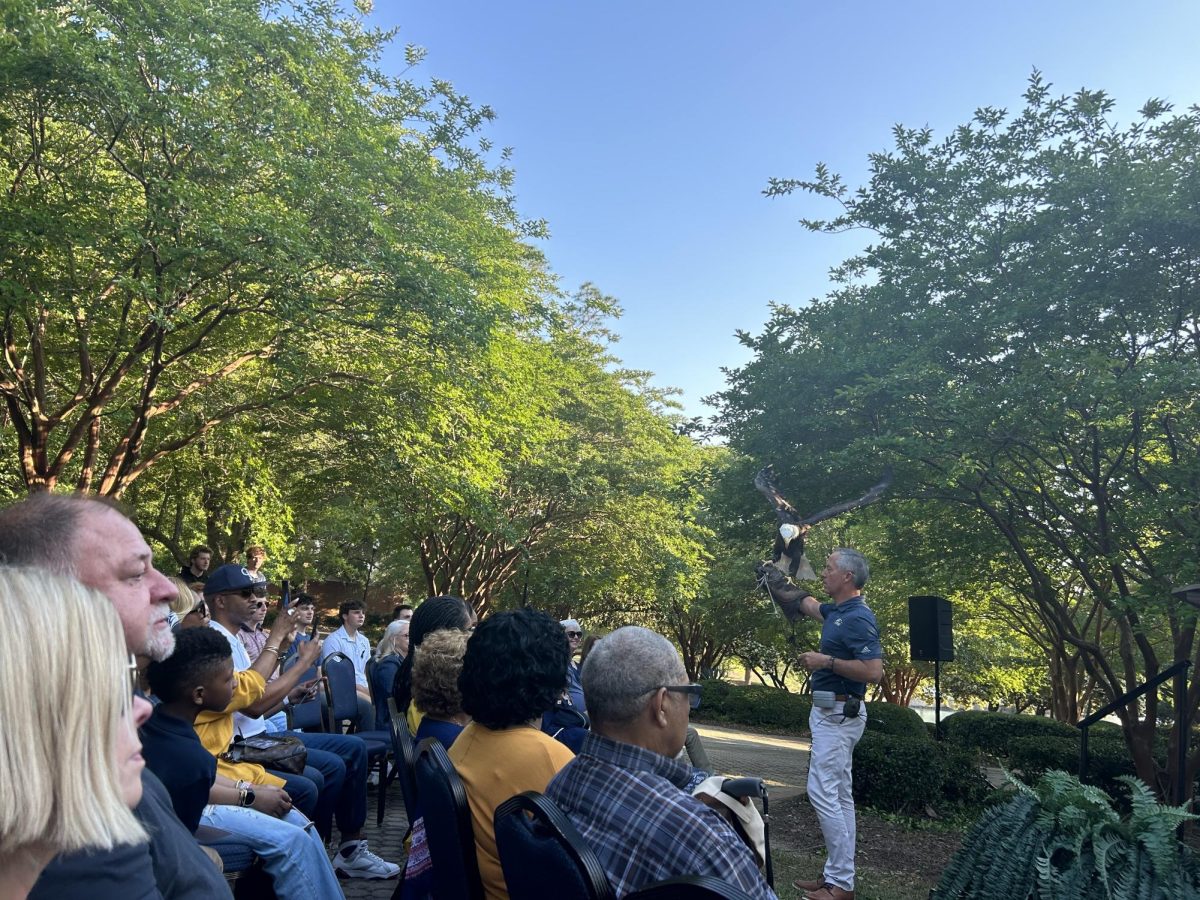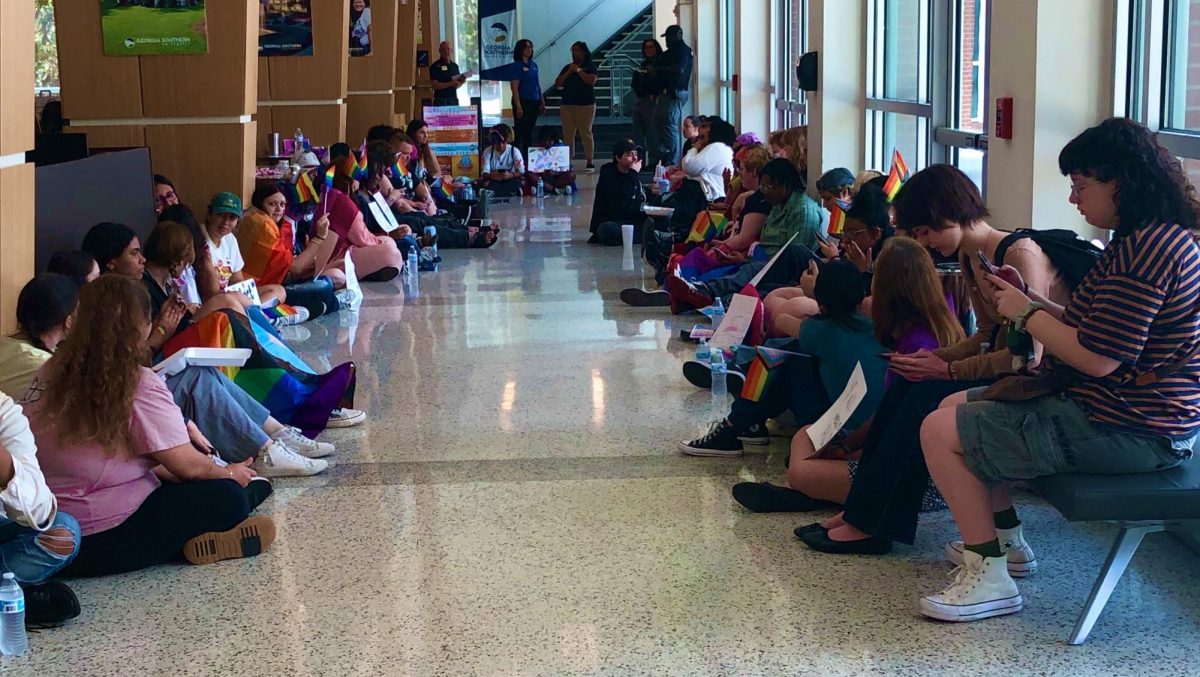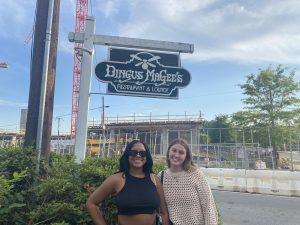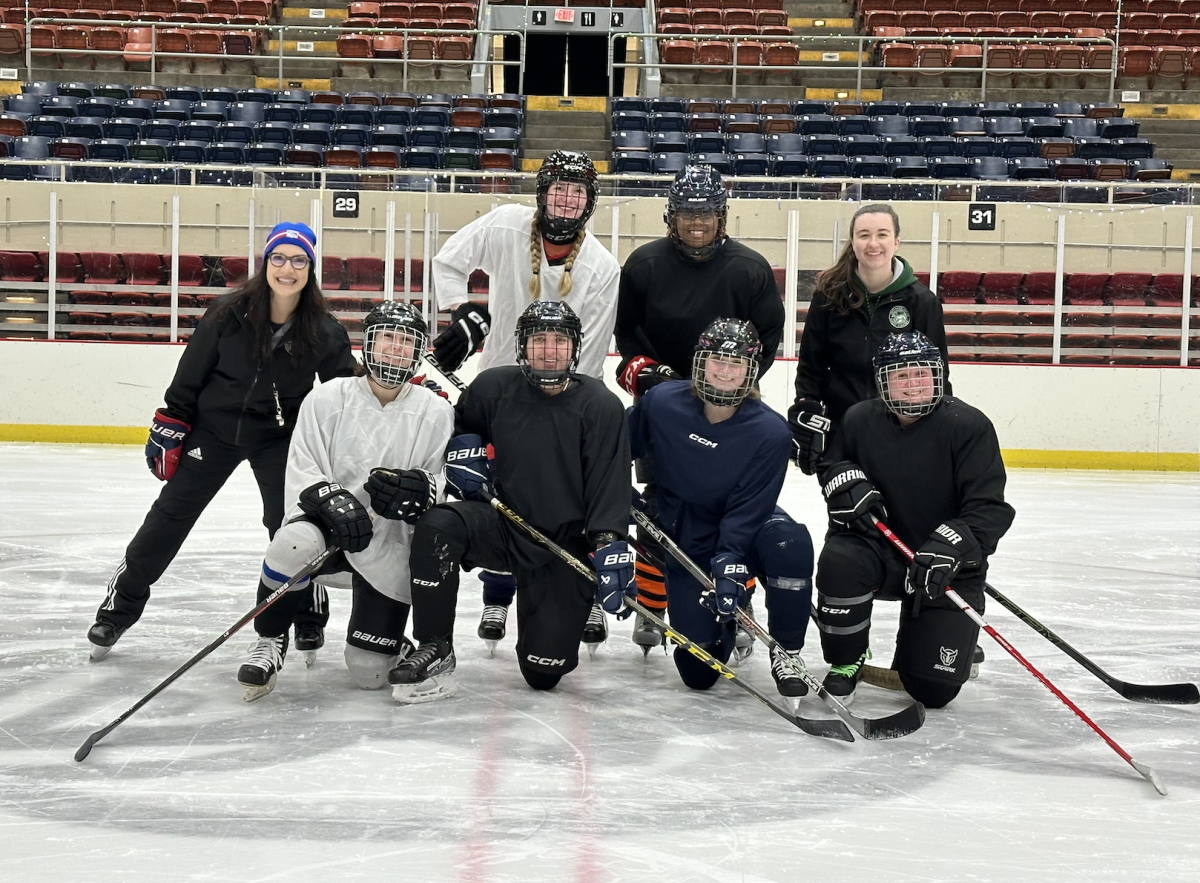Intimate family relics speckle the parlor in the old row house on East Charleston Street in Savannah: a wobbly baby stroller by the doorway, a childhood portrait of a wealthy cousin, gilded molding funded by the same wealthy cousin. Original hardwood floors and two fireplaces frame the double-parlor in the home where writer Flannery O’Connor lived as a child in the 1930s.
The Flannery O’Connor Childhood Home is a museum restored to its appearance in the Great Depression era. The museum sells O’Connor’s novels and collections, gifts and t-shirts, peacock feathers and magnets. Visitors can take tours around the house and attend lectures and readings. It is kept afloat by the Flannery O’Connor Childhood Home Foundation, a nonprofit led by president Michael Schroeder.
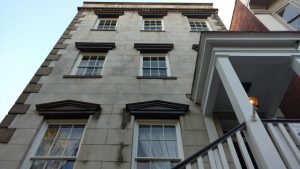
The Flannery O’Connor Childhood Home Foundation
I met Schroeder at The Gallery Espresso coffee shop in Savannah. Now retired, he taught English for years at Savannah State University. He wore a purple Flannery O’Connor t-shirt and was reading a book when I arrived.
He has been on the board of directors for the foundation for four years, taking the role of president for the first time this year. I asked him why he joined the foundation.
“Mainly, I was very interested in O’Connor to begin with, partly because my field is in English, American literature in particular, and so when I moved to Savannah, it just seemed natural to start focusing more on her,” Schroeder said.
O’Connor wrote, among other works, short story collections “A Good Man is Hard to Find” and “Everything That Rises Must Converge.” She lived in Savannah until she was 13 years old when her family moved to Milledgeville, Georgia, according to the museum tour.
After he began attending events at the museum, he became more involved with the foundation. Today, he leads the board’s bi-monthly meetings.
“Mainly, I do whatever I’m told to do,” Schroeder said. “We have plenty of people who would like to tell me what to do. I lead the meetings, I try to keep the agenda going, and just sort of oversee things and work closely with Cody Shelley, who is our administrator of the home.”
Shelley said the administrative position opened at the right time for her in 2016, and it felt like a good fit. A longtime fan of O’Connor, she was a women’s studies major in college and had a background in nonprofit work.
“I read her first as a teenager, and for me personally, as kind of an offbeat southern woman, she definitely stuck with me,” Shelley said.
Schroeder said the board is working with local tourism offices to try to get more visitors. He said many of the people who visit the home are Savannah locals or fans of the writer.
“I think some people come become it’s relatively inexpensive to visit, and it’s different, because it’s not one of these big houses like most that we have in Savannah,” Schroeder said. “Instead, it’s this small little row house with furniture from the 1930s because we want to show the way it would’ve been when Flannery O’Connor was there.”
The foundation stays afloat from a combination of income sources: donations, admission fees, fundraisers and rent payments.
“One regular piece of income is the rent from the bottom floor, because that’s an apartment that we rent. So that’s the only thing that we can really count on,” Schroeder said.
Schroeder said the foundation received a large donation at a deceased person’s bequest, but the board was unaware of the donation for several years.
“It had sat there for at least ten years before they bothered to let us know that we had this money,” Schroeder said. “So when that was settled, we had this large sum of money coming in exactly when we needed it. Otherwise, we’d be in trouble. We’d be scrambling with some kind of capital campaign.”
The foundation used the donation for much-needed maintenance: a new roof, window maintenance and a new air conditioning unit, Schroeder said.
“We’re a small, self-sustaining nonprofit,” Shelley said. “We charge eight bucks per person, we sell books out of a little tiny closet.”
Shelley said the nonprofit is not funded by large grants.
“We gotta keep the lights on, and part of that is making sure people know that we’re here and maintaining a really great internet presence so that folks can find us and identify us, but it’s a balancing act,” Shelley said. “We can’t accomodate a hundred people every day. This house is tiny.”
The museum has to find the sweet spot, Shelley said, where people know about the museum, but do not arrive in numbers too large to allow inside.
A tour and a lecture
On a cool October Sunday, I walked into the Flannery O’Connor Childhood Home for a tour. The other guests—a stylish married couple with a toddler, a woman in athletic clothes, a group from Sigma Tau Delta, the English Honor Society at Georgia Southern University—took photos and notes as Shelley led us into each room of the museum.
Shelley showed us the backyard where O’Connor once taught her pet chicken to walk backwards, an original stained glass window in a wooden door, a bathtub where O’Connor frightened her friends with the original Grimm’s Fairy Tales. O’Connor’s childhood bed was little more than a hospital cot, its thin mattress barely covering the wooden slats. Her infant playpen and crib was a netted box, marketed by old catalogues as a way to prevent mosquito bites. It stayed in her parents’ room, just beneath the window where O’Connor could see the Cathedral of St. John the Baptist in the distance. Shelley said this likely influenced O’Connor, who was a devout Catholic.
There were artifacts: books where a young disgruntled O’Connor had scribbled negative reviews on the first pages, old drawings she made in college, the stroller her parents had used in her infancy. Shelley introduced each artifact and detail in the house within longer anecdotes about O’Connor and her family. She told us O’Connor’s real first name was Mary, but the writer felt “Mary O’Connor” made her seem like an “Irish washerwoman,” so used her middle name, Flannery, instead. She told stories about O’Connor’s wealthy cousin, who lived in the expensive house next door and catapulted young O’Connor to brief fame, getting her trained chicken in the news.
“My favorite thing is sharing Flannery’s crib and view of the cathedral, because it kind of ties everything together,” Shelley said in a phone call after the tour. “It’s symbolic of the experience that she had.”
After the tour, the students and professor from the English honor society waited for the visiting speaker, poet Olivia Stiffler, to arrive. They helped Shelley arrange the living room with folding chairs. I pushed O’Connor’s stroller into the sunroom.
As several of the students left to get coffee before the lecture, one student and the professor remained. The student was a freshman, an English major named Jazmyne Josse. I asked her why she wanted to study literature.
“When I was little, I loved to read. I couldn’t do anything else but read,” Josse said. “Growing up, I used to have so many books. I was even a million-word reader when I was in eighth grade. I didn’t see myself doing anything else other than dealing with literature.”
Josse said she recognized O’Connor’s name from her high school coursework.
“When I was a senior in high school, we studied Flannery O’Connor, and at first I didn’t realize the name until we got here and I heard the title ‘A Good Man is Hard to Find,’ and I was like, oh my goodness, this is from my class,” Josse said.
Mary Villeponteaux, the English professor who accompanied the group, told me she has lived in Savannah for 13 years and had taken the museum tour four or five times. I asked her what she thought of the tour that day.
“I thought it was wonderful, and my favorite part is the way you can really get a sense of what her life was like, down to all those little details,” Villeponteaux said.
Later, the poet Olivia Stiffler stood at the podium to speak to the audience that packed the narrow double parlor. Between reading her poems, she talked about her life and her relationship with her parents. She quoted O’Connor during her lecture:
“Everywhere I go, I’m asked if I think the universities stifle writers. My opinion is that they don’t stifle enough of them. There’s many a best-seller that could have been prevented by a good teacher,” Stiffler said, quoting O’Connor.
During her lecture, Stiffler said she initially felt intimidated while preparing to deliver her lecture at the museum. While she signed books in the dining room, I asked her what she meant.
“I’m not used to being in the company of high rollers, and this list of people who are going to speak here is kind of a group of high rollers,” Stiffler said. “I don’t go out that much and do all that much out in the world, so it’s a big deal to prepare and try to do something worthwhile and be in the company of folks like, the kind of people who come in here to talk.”
Stiffler sprinkled quotes from O’Connor throughout her lecture, tying them to her own experiences and poetry. I asked her when she first encountered O’Connor.
“I didn’t know anything about her until I came to Savannah,” Stiffler said. “You can’t really live in Savannah without encountering some of these writers, so I picked up one of her books and started reading her short stories, which are just so different. They are phenomenal, and they are unique.”
In the dining room, I talked to two more members of the English honor society about the tour and lecture. Brady Gwen, senior English and French major, said the group is trying to do monthly activities outside of campus.
“We found these free lectures and the tour of Flannery O’Connor’s childhood home, and she’s a big part of Georgia southern literature, so we thought it would be a cool free activity to boost community and get a little bit out of our weekend,” Gwen said.
Gwen said she found the tour fun and educational.
“The tour guide, Cody, was super animated,” Gwen said. “Everything she said felt like an anecdote, like a personal story – all the little touches in the house and the artifacts they have of her childhood.”
Hannah Ogden, junior English major, had not heard of O’Connor until they visited the museum that day, but said she plans to check out her work.
“I thought it was really interesting. I really liked the view from her bedroom, and how it showed how as she was young, and her Catholic upbringing, and really influenced her life. And the tour guide was amazing,” Ogden said.
Shelley said the home attracts a niche audience.
“Not a ton of people wander in off the street. Most of the people who come to see us are pretty interested in Flannery, so they’re really excited to be here and nobody is being dragged in, so it’s really gratifying to get to work with people who are excited to be here,” Shelley said.
Shelley said the museum is like a pilgrimage for fans of the writer, and that she enjoys sharing O’Connor’s stories and experiences with the visitors.



